Fisher Body Number Plate - 1964
[ Preface ] | [ 1964 ] | [ 1965 ] | [ 1966 ] | [ 1967 ] | [ 1968 ] | [ 1969 ] | [ 1970] | [ 1971 ] | [ 1972 ]
[ Atlanta ] | [ Baltimore ] | [ Euclid ] | [ Fremont ] | [ Kansas City ] | [ Van Nuys ] | [ Oshawa ]
Introduction: For quite some time I’ve had an intense interest in Fisher Body Number plates, a.k.a. trim tag, cowl tag, firewall tag, etc. for 1964 through 1972 Chevelles - hereafter referred to as ‘trim tag’ since that seems to be most common moniker for these little jewels. Their diversity, not only between the different years but between the different plants in a given year, has always fascinated me. This page deals only with 1964 Chevelle trim tags.
The introductory model year of the Chevelle, 1964, saw its final assembly production occur at 5 plants in the U.S. - Atlanta, Georgia - Baltimore, Maryland - Fremont, California - Kansas City, Missouri - and Van Nuys, California - plus Oshawa, Ontario in Canada. It’s also interesting to note that Fisher Body had a Fisher Body plant in Euclid, Ohio and this plant supplied bodies to at least Atlanta and Kansas City in 1964, most notably the 300 series 2-door station wagon (53/5415) and Malibu & Malibu SS (35/36/37/3867) convertibles. Whether this was a GM decision, a union negotiation, or simply that Atlanta and Kansas City were not geared up to meet the expected demands of these particular body styles is not known. I have examples of convertibles with trim tags from Kansas City proper (but to date none from Atlanta proper), so it’s anybody’s guess as to the reasoning for building certain bodies at the Euclid, Ohio Fisher Body plant and shipping them to Atlanta and Kansas City for final assembly.
I’ll not attempt to decode what each trim code, paint code, and, where applicable, group option codes in this series represent. Click on any year's link in the navigation menu at the top of the page and choose the appropriate link on that year's home page where you’ll find links for detailed information for interior, paint, and group option codes.
All research to date indicates that each Fisher Body plant assigned body numbers in sequential order based on the particular Fisher Body style number. This means that a 2-door sedan built immediately after a Malibu SS convertible would not have sequential body numbers, or even close, since they are different styles. Depending on production numbers of a particular body style number throughout the model year, the above 2-door sedan and Malibu SS convertible would be vastly different on a given day of assembly but the next 2-door sedan or Malibu SS convertible would have a sequential body number for that particular style.
The Fisher Body unit number has nothing to do with the vehicle identification number (VIN) assigned by GM at final assembly and if any were to match, it’d be a coincidence.
The 1964 model year is the only year that the series designation for Chevelle 300, Malibu, and Malibu SS begins with 5x and the VIN begins with the model year (4). Fisher Body Style numbers are all 4-characters long.
With that, let's begin 1964.
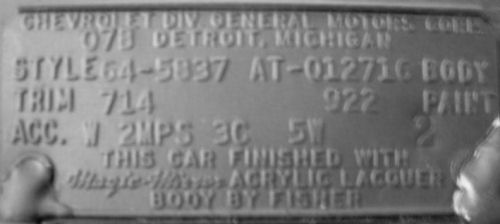
The 1964 Atlanta trim tag has 4 lines of information. In addition,
a base (blank) trim tag has the verbiage:
CHEVROLET DIV GENERAL MOTORS CORP
DETROIT, MICHIGAN
The bottom of the trim tag has the verbiage,
THIS CAR FINISHED WITH
Magic-Mirror ACRYLIC LACQUER
BODY BY FISHER
The first information line has the body assembly date consisting of the month as a 2-digit number and a single letter (A…E) designating the week. When the month is a single digit month (January through September) the month number is padded with a leading zero (0) such as 01, 02, 03, etc. This body date is embossed to the left of the DETROIT, MICHIGAN stamping. In the example 07B is the 7th month (July) and “B” represents the 2nd week.
The second information line contains the word STYLE followed by the model year (64), a hyphen and the Fisher Body style number. Next is the designation for the plant location, AT for Atlanta, another hyphen and the Fisher Body unit number followed by BODY. It should be noted that the Fisher Body style number (5837 for a Malibu SS sport coupe in the example) has nothing to do with the GM VIN series/model designation. That means the 5837 does not indicate a V8 engine just because the second digit is an even number. Fisher Body at Atlanta did not designate the style number as a V8 or L6 engine. Generally the Fisher Body unit number, 012716 in this case, was sequential for the particular STYLE number.
The third information line contains the word TRIM followed by a 3-digit number indicating the seat type and color. Next is a 3-digit number indicating the exterior paint color, and finally the word PAINT.
The fourth information line contains the abbreviation ACC. (for accessory) with various letters and numbers indicating the various option groups (1 through 5) with a number and letters for various options the car was ordered with within those groups. It should be noted that the first group of options does not have the number “1,” the letter “W” is in the first option group in this example.
The hand stamped number (2 in this case) is believed to be a final inspector’s stamp. This 1- or 2-digit hand stamped number has been found in various locations on the trim tag so it won’t always be in the same location.
The Euclid, Ohio Fisher Body plant also supplied various bodies to the Atlanta final assembly plant; most notably the 2-door station wagon but Malibu and Malibu SS convertibles were also supplied to Atlanta. Whether the Fisher Body plant at Atlanta supplied any Malibu or Malibu SS convertibles to the final assembly plant is not known but I know I have no convertible examples for Atlanta except those supplied by the Fisher Body plant at Euclid, Ohio. More on the Euclid plant later.
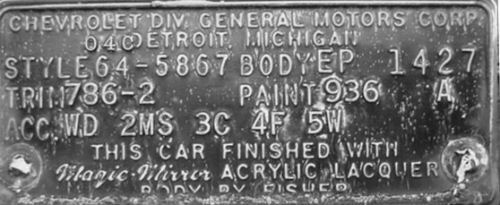
There are some differences in the trim tags from Euclid. Of note are the verbiage BODY and PAINT precede the body number and paint code. This lasted until sometime around June of 1964 when the verbiage BODY and PAINT moved to the far right as typically found on other plant’s trim tags. The designation EP is shown after BODY to designate Euclid and the letter “A” is shown after the paint code to designate this body was destined for the Atlanta final assembly plant. More on the Euclid, Ohio plant later.

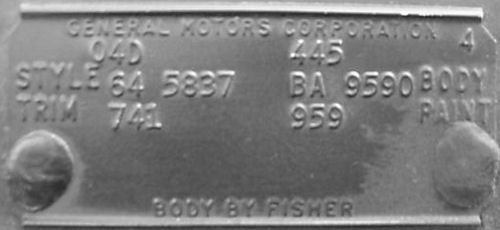
Sometime between the end of the calendar year 1964 and at least April of 1965, Baltimore changed the physical trim tag itself. Note the early year example (top image) shares much the same layout as other plants but changed the information presented by mid to late model year. Also note the verbiage change of the bottom line between the early and late trim tags.
The first information line has the body assembly date consisting of the month as a 2-digit number and a single letter (A…E) designating the week. When the month is a single digit month (January through September) the month number is padded with a leading zero (0) such as 01, 02, 03, etc. Next is a 3-digit number that corresponds to the Job Number found on trim sheet for that car. Lastly, the first line (although found in other locations throughout the model year, most notably the bottom right corner as well) is a single number. It’s believed this number is for the body jig, or gate, the body was assembled on and used for quality control.
The second information line contains the word STYLE. Note the early model year trim tags did not show the model year; the model year did not appear on Baltimore trim tags until the tag style change. Also note that there is no hyphen character between the model year (64) and style number. All other plants separated the model year and style number with a hyphen character. Next is the designation for the plant location, BA for Baltimore, and the Fisher Body unit number followed by BODY. It should be noted that the Fisher Body style number (5837 for a Malibu SS sport coupe in the example) has nothing to do with the GM VIN series/model designation. That means the 5837 does not indicate a V8 engine just because the second digit is an even number. Fisher Body at Baltimore did not designate the style number as a V8 or L6 engine. Generally, the Fisher Body unit number, 4476 and 9590 in these examples, was sequential for the particular STYLE number.
The third information line contains the word TRIM followed by a 3-digit number indicating the seat type and color. Next is a 3-digit number indicating the exterior paint color and finally the word PAINT.
The fourth information line has ACC. and any group coded options that the car was ordered with.

Baltimore-assembled El Caminos had their bodies built at the Euclid, Ohio Fisher Body plant. There are some differences in the trim tags from Euclid. Of note are the verbiage BODY and PAINT precede the body number and paint code. The designation EP is shown after BODY to designate Euclid and the letter “B” is shown after the paint code to designate this body was destined for the Baltimore final assembly plant. Unlike the Baltimore plant itself, the model year and style number were separated with a hyphen character. More on the Euclid, Ohio plant later.
Atlanta
The Euclid, Ohio Fisher Body plant built various body styles for final assembly at Atlanta, Baltimore, and Kansas City. Most notably were the 2-door station wagon but at least El Caminos, Malibu, and Malibu SS convertibles were also built in Euclid. Fisher Body at Euclid did not designate the style number as a V8 or L6 engine.
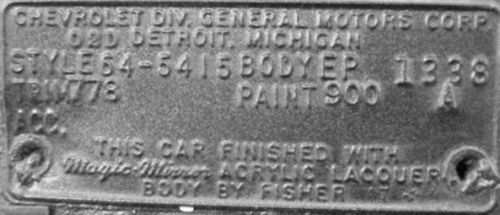
A typical Euclid, Ohio trim tag for a 2-door station wagon destined for the Atlanta final assembly plant prior to June of 1964. Note the verbiage BODY and PAINT precede the body number and paint code; the letter “A” after the paint code designates Atlanta.
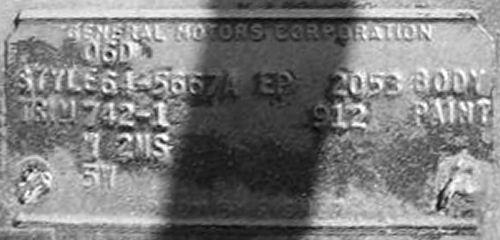
A typical Euclid, Ohio trim tag for a Malibu convertible destined for the Atlanta final assembly plant from June 1964. Note the verbiage BODY and PAINT are in the ‘standard’ far right location; the letter “A” after the style number designates Atlanta on this tag. Also note the different verbiage on the base tag itself in regards to the CHEVROLET DIV. GENERAL MOTORS CORP and DETROIT, MICHIGAN on the top two lines of the early style tag and simply GENERAL MOTORS CORPORATION on the later tag. Also gone is the verbiage THIS CAR FINISHED WITH Magic Mirror ACRYLIC LACQUER on the bottom lines and only the verbiage BODY BY FISHER remains.
The TRIM code number in this convertible example includes “-1” indicating the convertible top color, white in this instance.
Baltimore

A typical Euclid, Ohio trim tag for a pickup (El Camino) destined for the Baltimore final assembly plant from April of 1964. Note the verbiage BODY and PAINT precede the EP code for the Euclid plant, the body number and paint code; the letter “B” after the paint code designates Baltimore.
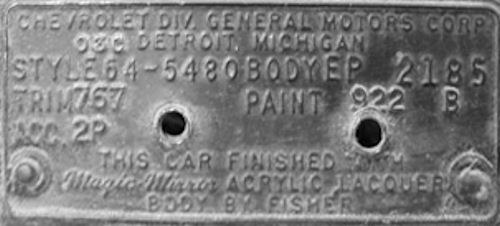
On this El Camino tag destined for Baltimore, the particular STYLE number 5480 does not mean a V8 engine and, in fact, the VIN on this El Camino begins with 45380 indicating an 6-cyl engine.
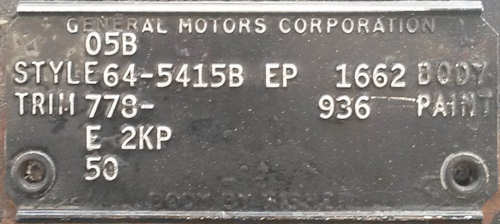
Euclid also build 300 series 2-door station wagons for Baltimore. Note in this second style blank the destination plant designation is moved to just after the style number.
Kansas City
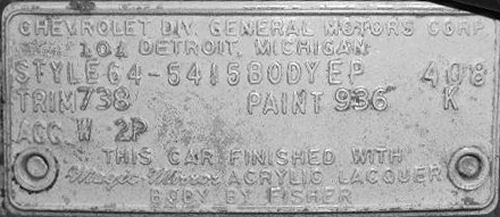
A typical Euclid, Ohio trim tag for a 2-door station wagon destined for the Kansas City final assembly plant from October of 1963. Note the verbiage BODY and PAINT precede the body number and paint code; the letter “K” after the paint code designates Kansas City.
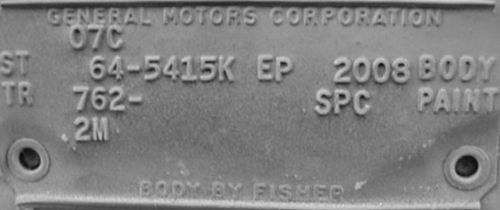
A typical Euclid, Ohio trim tag for a 2-door station wagon destined for the Kansas City final assembly plant from July 1964. Note the verbiage BODY and PAINT are in the ‘standard’ far right location; the letter “K” after the style number designates Kansas City. Of special note on this particular is the SPC paint code indicating this car was ordered with special order paint color. Also note the different verbiage on the base tag itself in regards to the CHEVROLET DIV. GENERAL MOTORS CORP and DETROIT, MICHIGAN on the top two lines of the early style tag and simply GENERAL MOTORS CORPORATION on the later tag. Also gone is the verbiage THIS CAR FINISHED WITH Magic Mirror ACRYLIC LACQUER on the bottom lines and only the verbiage BODY BY FISHER remains.
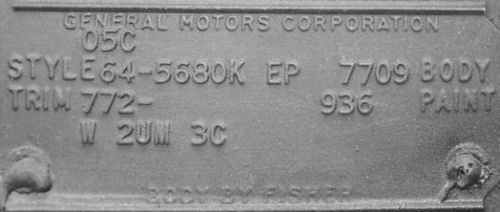
A typical Euclid, Ohio trim tag for a pickup (El Camino) destined for the Kansas City final assembly plant from May of 1964. Note the verbiage BODY and PAINT are in the ‘standard’ far right location; the letter “K” after the style number designates Kansas City.
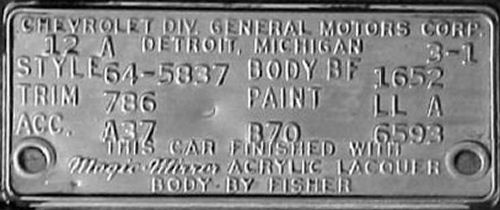
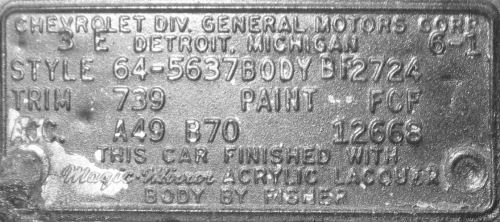
The first information line has the body assembly date consisting of the month as a 1- or 2-digit number and a single letter (A…E) designating the week. When the month is a single digit month (January through September) the month number is not padded with a leading zero (0) but simply shown as 1, 2, 3, etc. This body date is embossed to the left of the DETROIT, MICHIGAN stamping. In the examples 12A is the 12th month (December) and “A” represents the 1nd week and 3E is the 3rd month (March) and “E” represents the 5th week. The upper right hand corner also contains a dashed number (such as 3-1) that correlates with the Fisher Body job number.
The second information line contains the word STYLE followed by the model year (64), a hyphen and the Fisher Body style number. Next is the designation for the plant location, BF for Fremont, followed by BODY, and the Fisher Body unit number. It should be noted that I have one very early Fremont Malibu SS trim tag without the model year (64) shown. It also does not show a body assembly date and has body number 9 so this may be a pilot car and not indicative of full production 1964 Chevelles at Fremont.
Fremont is the only U.S. plant to match the Fisher Body Style number to the GM series/model designation in the VIN, meaning Fremont would use a style number such as 5537 to designate an L6 engine in the car where other plants would use a style number of 5637.
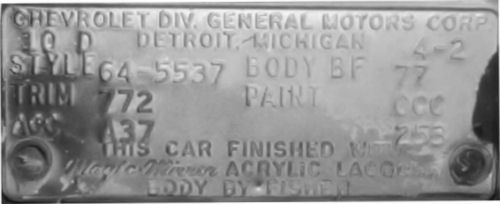
The third information line contains the word TRIM followed by a 3-digit number indicating the seat type and color. Next is the word PAINT, then a 3-letter sequence indicating the exterior paint color. Unlike the other 1964 final assembly plants, Fremont used a 3-letter code for the exterior body paint as opposed to a 3- or 4-character number. In 1964 at Fremont only, the letters represented the upper body color, lower body color, and wheel paint color codes and 1964 is the only year the letter codes were used as upper/lower paint codes; 1965 and later years the sequence was lower/upper body colors. There have been some anomalies found such as the FCF paint code in one of the examples shown. Typically this would code to Silver Blue (F) upper, Ermine White (C) lower, and Silver Blue painted wheels. This particular two-tone combination is not shown to be an option although an Ermine White upper and Silver Blue lower is. Whether this is a special order color scheme or a mistake on the trim tag is not known. The wheel color (F) in this case, would be consistent with a 1964 Chevelle with standard hub caps and not full wheel covers. Black wheels (paint code A) are typically used when full wheel covers are ordered and standard hub caps usually come with lower body color paint. Variations have also been found where some 3-character paint codes are contiguous such as CCC and some have a space between the body colors and wheel color such as LL A.
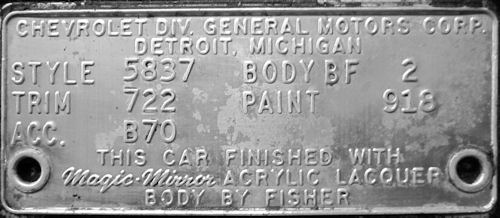

There are at least two examples of vary early Fremont trim tag with
no body dates and body numbers of 2 and 9 that show the paint code with
a 3-digit number instead of a 2- or 3-letter code. It is not known when
the 3-digit paint code changed to a 2- or 3-letter code.
The fourth information line contains the abbreviation ACC. (for accessory) with various letters and numbers indicating the various accessories. On the right side of the fourth line is a 2- to 5-character number corresponding to the manifest sequence number from production broadcast notice and this number on the trim tag may be truncated from the original number on the manifest.
Kansas City had several variations on their trim tags for 1964; notably the body assembly date code, base tag verbiage, and convertible top color designations.
This first example is applicable to trim tags prior to at least 12D, December 4th week of 1963.
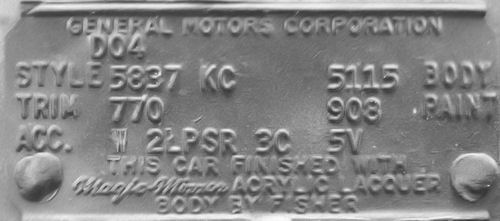
Note the body assembly date is not the typical month number and week letter. September dated bodies used a body date code such as 912 to indicate September 12, 024 (the number 0 and not the letter O) for October 4, N12 for November 12, and D04 for December 4. Sometime in December of 1963 Kansas City changed to the more typical 2-character month number and single letter week code. Also note the model year (64) is not shown on these early style tags and the group option codes are listed on the last line preceded with ACC.
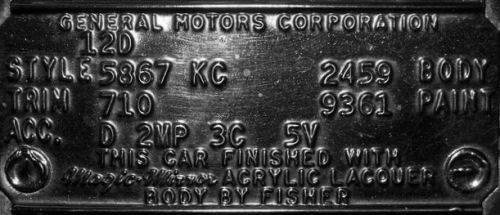
This December 4th week body date trim tag has now reverted to the standard month/week designation for the body date; still missing is the model year in the style. Kansas City is the only 1964 final assembly plant to list the convertible top color in the paint code by using a 4th digit, “1” for a white convertible top and “2” for a black convertible top. In the sample above the paint code 9361 is for Ermine White (936) with a white (1) convertible top.
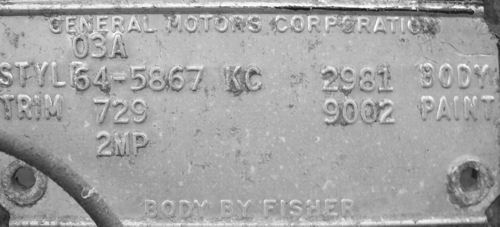
Sometime between December of 1963 and March of 1964 the verbiage THIS CAR FINISHED WITH Magic Mirror ACRYLIC LACQUER disappeared from Kansas City trim tags and the model year (64) appeared in the style. This tag is another example of a convertible with the extra digit in the paint code; in this case the digit is the number “2” for a black convertible top.
See the Euclid, Ohio plant section for El Camino trim tag information for Kansas City built El Caminos.
Van Nuys was the second Chevelle plant in California for 1964. Van Nuys assembled the Chevelle in 1964 and not return to Chevelle production until the 1970 model year.
Unlike other 1964 Chevelle assembly plants, Van Nuys used the same verbiage format on the trim tag throughout the production year as far as the first and second line as well as the last three lines. This also resulted in the BODY and PAINT verbiage remaining before the body number and paint code.

The first information line here contains the Fisher Body assembly
date, 10C for October 3rd week.
The second information line shows the model year (64), a hyphen character,
and the Fisher Body style number. After the BODY text is VN designating
Van Nuys followed by the body number 253.
The third information line shows the TRIM and PAINT codes. Note for the convertible, the convertible top color is designated after the interior trim code. The paint code is listed as a 3-digit number.

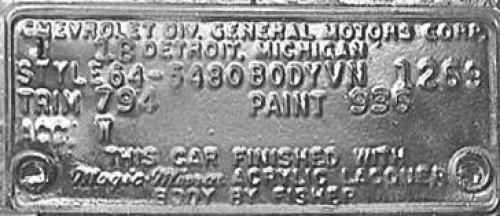
On the El Camino trim tag, when the seat type is a bucket seat, a -B follows the trim code for the seat color. Trim code 726-B is red bucket seats while 194 is a red bench seat. This was only done on the El Camino trim tag and was not done on any other body style. Below is a Malibu SS with trim code number 786 for red bucket seats.
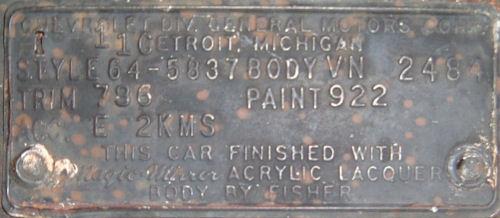
The fourth information line shows ACC. Followed by group options as applicable.
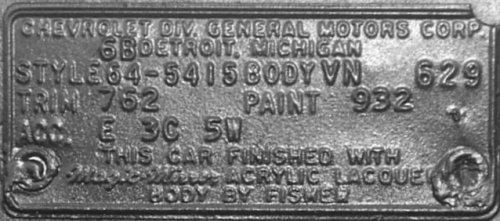
As noted, Van Nuys used the same general Fisher Body Number plate throughout the 1964 model year. Van Nuys is also the only (at this time) known final assembly plant that had the in-house Fisher Body plant building the 2-door station wagon as opposed to having this body style built at Euclid, Ohio and shipped to Van Nuys.
The Oshawa, Ontario plant Style number does indicate whether the car was to have an L6 or V8 engine.
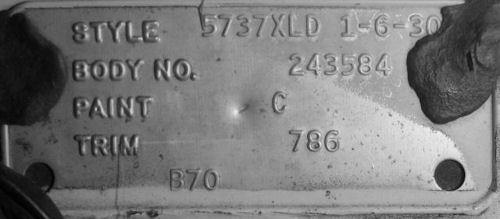
Chevelles built in Canada have trim tags vastly different from their U.S. counterpart and have 5 lines of information.
The first information line has the word STYLE followed by the particular body style designation, 5737 on this example. The XLD on this example also indicates the car was destined for export outside of Canada or U.S.
Next is the assembly date; 1 is for the first shift (of 2 at the plant), a hyphen, a number for the month (6 for June), a hyphen, and a number for the day of the month (30 is the day of the month). Since the trim tag went on the car at the start of the assembly cycle and it might take anywhere from 3 to 5 days for a car to complete the assembly process, it's assumed this date is when the car was scheduled to begin assembly, not when it finally rolled off the assembly line.
The second information line has BODY NO. followed by a 6-digit number. It's believed this body number is sequential regardless of the style. It is not known at this time what the starting number might have been.
The third information line has the word PAINT and is followed by a single letter indicating the color.
The fourth information line has the word TRIM and is followed by a 3-digit number indicating the interior trim code.
The fifth information line has any RPO option codes that might be applicable. In the example only the RPO code B70 (padded dash) was deemed necessary.

 Home
Home Decode
Decode Tech
Tech Tools
Tools Dale's Coins/CDs
Dale's Coins/CDs Contact
Contact Chevelle
of the Month
Chevelle
of the Month Things
For Sale
Things
For Sale Custom
Stickers
Custom
Stickers